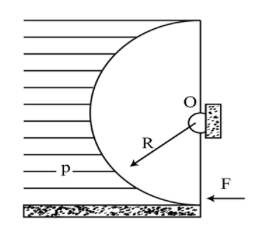
A light semi-cylindrical gate of radius R is pivoted at its midpoint O, of the diameter as shown in the figure holding liquid of density$\rho $. The force F is required to prevent the rotation of the gate is equal to

A.$2\pi {{\rm{R}}^3}\rho g$
B.$2\rho g{{\rm{R}}^3}l$
C. $\dfrac{{2{R^2}l\rho g}}{3}$
D. None of these

Answer
569.4k+ views
Hint:We know that fluid is a combination of liquids, gases and plasma. It has no definite shape; its pressure applies in all directions. Fluid pressure can also be amplified through the hydraulic mechanism and changes with the velocity of fluids.
Complete step by step answer:
According to the question, the volume of semi-cylinder with radius r is given by ${\rm{V}}\;{\rm{ = }}\;\pi {r^2}h$
Now we know density =mass/volume
So, we calculate the mass by putting the value of volume and density
$\therefore \;\rho (density) = \;\dfrac{m}{{\pi {r^2}h}}$
$ \Rightarrow \;m = \pi {r^2}h\rho $
Where r is radius of cylinder and h is height.
Now, the force required to stop the rotation ${\rm{F}}\,{\rm{ = mg}}$
Where g as (acceleration due to gravity).
$\therefore {\rm{F}}\;{\rm{ = }}\pi {{\rm{r}}^2}h\rho g$
Hence the force required to stop the rotation${\rm{F}}\;{\rm{ = }}\pi {{\rm{r}}^2}h\rho g$,
so the correct option (D) none of these.
Note: Gravity acts on each fluid molecule. The force is always exerted as the centre of mass of the fluid molecule and direction is towards the centre of mass of the body exerting the force. Therefore the fluid body moves in the direction its net acceleration, dictated by the sum of the acceleration of the individual particle.
Pressure is a scalar quantity defined as force per unit area where the force acts in a direction perpendicular to the surface.
Complete step by step answer:
According to the question, the volume of semi-cylinder with radius r is given by ${\rm{V}}\;{\rm{ = }}\;\pi {r^2}h$
Now we know density =mass/volume
So, we calculate the mass by putting the value of volume and density
$\therefore \;\rho (density) = \;\dfrac{m}{{\pi {r^2}h}}$
$ \Rightarrow \;m = \pi {r^2}h\rho $
Where r is radius of cylinder and h is height.
Now, the force required to stop the rotation ${\rm{F}}\,{\rm{ = mg}}$
Where g as (acceleration due to gravity).
$\therefore {\rm{F}}\;{\rm{ = }}\pi {{\rm{r}}^2}h\rho g$
Hence the force required to stop the rotation${\rm{F}}\;{\rm{ = }}\pi {{\rm{r}}^2}h\rho g$,
so the correct option (D) none of these.
Note: Gravity acts on each fluid molecule. The force is always exerted as the centre of mass of the fluid molecule and direction is towards the centre of mass of the body exerting the force. Therefore the fluid body moves in the direction its net acceleration, dictated by the sum of the acceleration of the individual particle.
Pressure is a scalar quantity defined as force per unit area where the force acts in a direction perpendicular to the surface.
Recently Updated Pages
Why are manures considered better than fertilizers class 11 biology CBSE

Find the coordinates of the midpoint of the line segment class 11 maths CBSE

Distinguish between static friction limiting friction class 11 physics CBSE

The Chairman of the constituent Assembly was A Jawaharlal class 11 social science CBSE

The first National Commission on Labour NCL submitted class 11 social science CBSE

Number of all subshell of n + l 7 is A 4 B 5 C 6 D class 11 chemistry CBSE

Trending doubts
What is meant by exothermic and endothermic reactions class 11 chemistry CBSE

1 Quintal is equal to a 110 kg b 10 kg c 100kg d 1000 class 11 physics CBSE

Difference Between Prokaryotic Cells and Eukaryotic Cells

What are Quantum numbers Explain the quantum number class 11 chemistry CBSE

What is periodicity class 11 chemistry CBSE

Explain zero factorial class 11 maths CBSE




